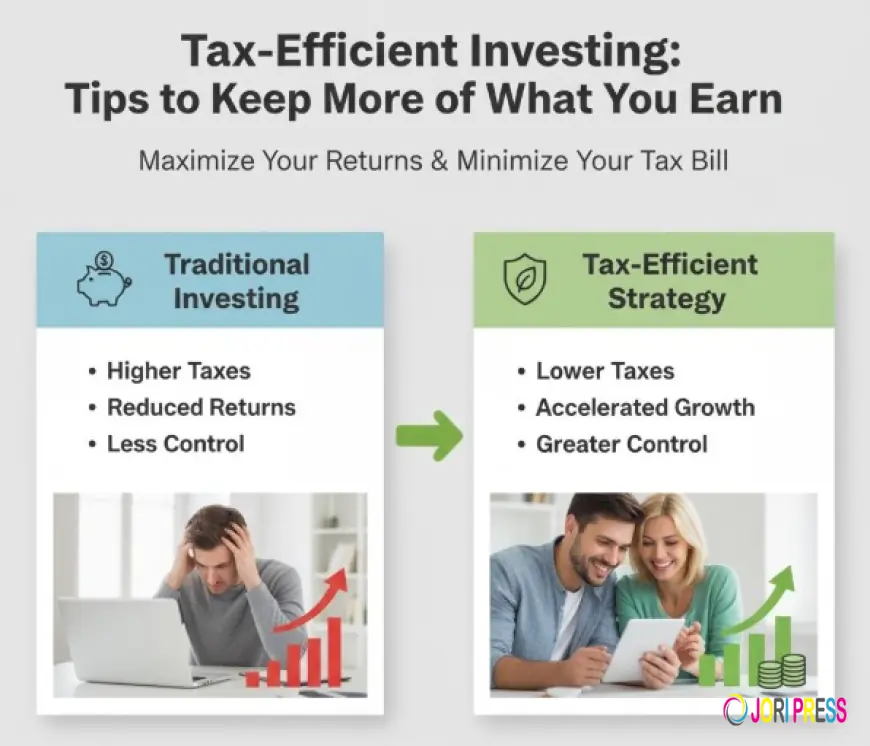Tax-Efficient Investing: Tips to Keep More of What You Earn

Investing is a powerful way to build wealth over time, but taxes can significantly erode your returns if you’re not careful. Understanding how to invest in a tax-efficient manner allows you to keep more of what you earn and accelerate your financial goals. This article explores practical strategies and tips to help you minimize tax liabilities while maximizing your investment growth.
Understanding Tax-Efficient Investing
Tax-efficient investing involves structuring your investments and managing your portfolio in a way that reduces the impact of taxes on your returns. Taxes can come in many forms, including income tax on dividends and interest, capital gains tax on the sale of assets, and taxes on distributions from mutual funds or retirement accounts.
By being mindful of how different investments are taxed and using strategies to defer or reduce taxes, you can enhance your overall investment performance. This doesn’t mean avoiding taxes illegally but rather making smart decisions within the framework of tax laws. For instance, utilizing tax-advantaged accounts like IRAs or 401(k)s can provide significant benefits, allowing your investments to grow without the immediate burden of taxation. Additionally, understanding the nuances of tax-loss harvesting can help offset gains with losses, further improving your tax situation.
Why Taxes Matter in Investing
Even a small difference in tax rates can compound over time and lead to substantially different outcomes. For example, if you earn a 7% annual return but pay 25% in taxes on those gains, your after-tax return drops to about 5.25%. Over decades, this difference can translate into tens or even hundreds of thousands of dollars in lost wealth. The impact of taxes is not just about the percentage taken from your gains; it also influences your investment choices and the overall strategy you employ.
Therefore, understanding how taxes affect your investments is crucial for long-term success. The goal is to maximize your after-tax returns, not just your pre-tax returns. This may involve choosing investments that are more tax-efficient, such as index funds or ETFs, which typically generate fewer taxable events compared to actively managed funds. Additionally, being aware of your holding periods can make a significant difference; long-term capital gains are often taxed at a lower rate than short-term gains, incentivizing a buy-and-hold strategy that can further enhance your investment outcomes. By incorporating these strategies, investors can create a robust portfolio that not only grows wealth but does so in a way that minimizes tax liabilities, allowing for a more effective accumulation of assets over time. For personalized financial guidance and to explore strategies tailored to your goals, visit Mercer Wealth Management.
Choose the Right Investment Accounts
One of the simplest yet most effective ways to invest tax-efficiently is by choosing the appropriate account type for your investments. Different accounts have different tax treatments, and knowing where to place your investments can save you a significant amount in taxes. Understanding the nuances of each account type can empower you to make informed decisions that align with your financial goals.
Tax-Advantaged Retirement Accounts
Accounts like 401(k)s, IRAs, and Roth IRAs offer tax benefits that can help your investments grow more efficiently. Traditional 401(k)s and IRAs allow you to contribute pre-tax dollars, reducing your taxable income today. The investments grow tax-deferred, meaning you don’t pay taxes on gains or dividends until you withdraw funds in retirement. This feature can be particularly advantageous for younger investors who have time on their side, as the compounding effect of tax-deferred growth can significantly enhance their retirement savings over the years.
Roth IRAs, on the other hand, are funded with after-tax dollars, but qualified withdrawals are tax-free. This can be especially beneficial if you expect to be in a higher tax bracket in retirement or want to avoid required minimum distributions. Additionally, Roth IRAs allow for contributions at any age as long as you have earned income, making them an attractive option for those who wish to continue working past traditional retirement age.
Health Savings Accounts (HSAs)
HSAs are another powerful tax-advantaged account, especially for those with high-deductible health plans. Contributions are tax-deductible, investments grow tax-free, and withdrawals for qualified medical expenses are also tax-free. This triple tax advantage makes HSAs a valuable tool for long-term investing. Furthermore, unlike Flexible Spending Accounts (FSAs), HSAs do not have a "use-it-or-lose-it" policy, allowing you to roll over your balance from year to year and build a substantial nest egg for future healthcare costs.
Moreover, HSAs can also serve as a supplementary retirement account. After age 65, you can withdraw funds for any purpose without penalty, although non-medical withdrawals will be taxed as ordinary income. This flexibility can make HSAs an essential part of a comprehensive financial strategy, especially for those looking to maximize their savings while preparing for both healthcare and retirement expenses.
Taxable Brokerage Accounts
While taxable accounts don’t offer the same tax benefits as retirement or health accounts, they provide flexibility and liquidity. However, it’s important to be mindful of the tax implications of trading and dividends in these accounts. Strategies such as holding investments long-term and harvesting tax losses can help manage taxes here. Long-term capital gains, which apply to assets held for over a year, are typically taxed at a lower rate than ordinary income, making it beneficial to adopt a buy-and-hold strategy when possible.
Additionally, taxable brokerage accounts allow for a diverse range of investment options, including stocks, bonds, mutual funds, and ETFs. This variety can enable investors to tailor their portfolios to their specific risk tolerance and investment objectives. Furthermore, the lack of contribution limits and withdrawal restrictions provides a level of freedom that can be particularly appealing for those who want to maintain control over their investments without the constraints imposed by retirement accounts.
Invest in Tax-Efficient Assets
Not all investments are created equal when it comes to taxes. Some generate regular taxable income, while others allow gains to accumulate without immediate tax consequences. Choosing tax-efficient assets can reduce your annual tax bill and improve your after-tax returns.
Index Funds and ETFs
Index funds and exchange-traded funds (ETFs) are generally more tax-efficient than actively managed mutual funds. Because they track a market index and have lower turnover, they generate fewer taxable capital gains distributions. ETFs, in particular, have a unique structure that allows investors to buy and sell shares with minimal tax events.
Tax-Exempt Municipal Bonds
Municipal bonds are debt securities issued by state and local governments. The interest income from these bonds is often exempt from federal income tax and sometimes state and local taxes as well. For investors in higher tax brackets, municipal bonds can provide attractive after-tax yields compared to taxable bonds.
Growth Stocks
Growth stocks typically reinvest earnings rather than paying dividends, which means you avoid paying taxes on income annually. Instead, you only pay capital gains tax when you sell the shares. This deferral of taxes allows your investment to compound more efficiently over time.
Utilize Tax-Loss Harvesting
Tax-loss harvesting is a strategy where you sell investments that have declined in value to realize a loss. These losses can offset capital gains from other investments, reducing your overall tax bill. If your losses exceed your gains, you can use up to $3,000 of those losses to offset ordinary income and carry forward any remaining losses to future years.
This strategy requires careful planning to avoid the “wash sale” rule, which disallows a loss deduction if you buy the same or a substantially identical security within 30 days before or after the sale.
By regularly reviewing your portfolio and harvesting losses, you can improve your tax efficiency and potentially increase your after-tax returns.
Consider Asset Location Strategies
Asset location refers to the practice of placing different types of investments in the most tax-advantaged accounts available. This strategy complements asset allocation and can have a meaningful impact on your tax bill.
Place Tax-Inefficient Assets in Tax-Advantaged Accounts
Investments that generate a lot of taxable income, such as bonds and actively managed mutual funds, are often best held in tax-deferred accounts like 401(k)s or IRAs. This shields the income from annual taxation until withdrawal.
Hold Tax-Efficient Assets in Taxable Accounts
Assets like individual stocks, index funds, and ETFs that generate minimal taxable income or allow for capital gains deferral can be held in taxable brokerage accounts. This allows you to take advantage of lower capital gains tax rates and control when you realize gains.
Be Mindful of Capital Gains Taxes
Capital gains taxes apply when you sell an investment for more than you paid for it. The rate depends on how long you held the asset and your income level. Long-term capital gains (for assets held more than one year) are taxed at lower rates than short-term gains, which are taxed as ordinary income.
Hold Investments for the Long Term
One of the simplest ways to reduce capital gains taxes is to hold investments for at least one year before selling. This qualifies you for the long-term capital gains tax rate, which can be significantly lower than short-term rates.
Plan Your Sales Strategically
Consider your income and tax situation before selling investments. For example, if you expect your income to be lower in a future year, it might make sense to delay selling until then to pay less in capital gains taxes. Additionally, spreading sales over multiple years can help avoid pushing yourself into a higher tax bracket.
Utilize Tax Credits and Deductions
While not directly related to investing, tax credits and deductions can reduce your overall tax burden, freeing up more money to invest. Some common credits and deductions include the Saver’s Credit for retirement contributions, deductions for investment interest expenses, and deductions for certain investment-related expenses.
Working with a tax professional can help you identify all the credits and deductions you qualify for, ensuring you don’t leave money on the table.
Work with Professionals
Tax laws are complex and constantly changing. Working with financial advisors, tax professionals, or certified public accountants can help you develop a tax-efficient investing strategy tailored to your unique situation. They can also help you navigate tax rules, identify opportunities, and avoid costly mistakes.
Many investors find that the cost of professional advice is more than offset by the tax savings and improved investment outcomes.
Conclusion
Tax-efficient investing is a critical component of building and preserving wealth. By understanding how different investments are taxed, choosing the right accounts, employing strategies like tax-loss harvesting and asset location, and planning your sales carefully, you can significantly reduce your tax burden and keep more of what you earn.
Remember, the goal is to maximize your after-tax returns, which ultimately determines how much wealth you accumulate over time. Start incorporating these tips today and watch your investments work harder for you.
What's Your Reaction?
 Like
0
Like
0
 Dislike
0
Dislike
0
 Love
0
Love
0
 Funny
0
Funny
0
 Angry
0
Angry
0
 Sad
0
Sad
0
 Wow
0
Wow
0


















































